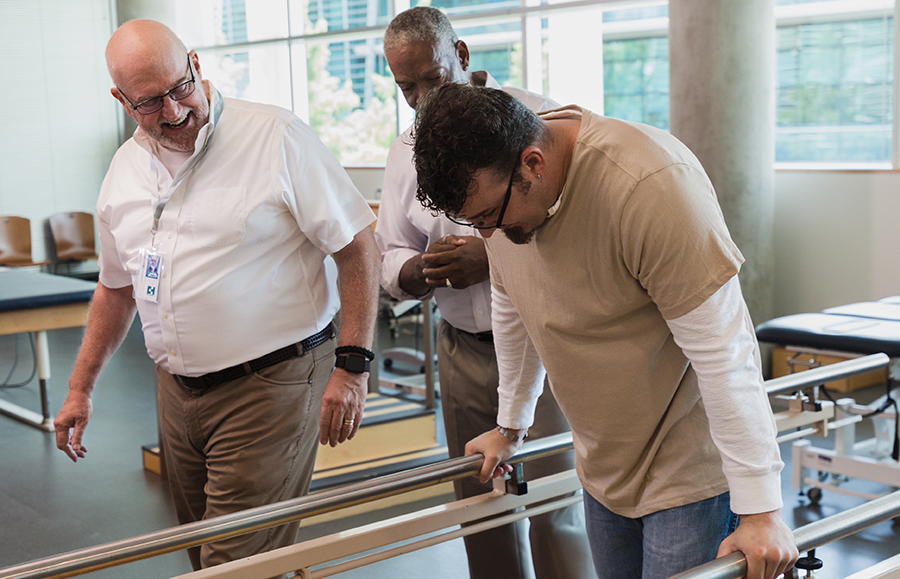Editor’s note: CMS has released more information on the Final Rule. Learn the latest from their 2022 Fact Sheet.
Prepare for 2022 with our comprehensive break down of the new assistant modifier rule.
Occupational and physical therapy organizations are required to report when an assistant (OTA or PTA) performs a service using the billing modifiers CO for OTAs and CQ for PTAs. Services with the assistant modifier will see a cost reduction in claim reimbursements beginning January 1, 2022.
These billing rules were originally proposed by the Centers for Medicare and Medicaid Services (CMS) in 2018. In 2020, organizations were required to begin reporting the assistant modifier when appropriate. And in 2022, organizations will begin to see a reduced reimbursement—as CMS puts it “85% of the otherwise applicable Part B payment”—for any CPT code line item containing the modifier CO or CQ.
CMS requires outpatient rehab clinics to use the CO and CQ modifier on any service that was “furnished in whole or in part by a PTA or OTA.” And “in part” was essentially defined as at least 10% of the service. The lack of clarity led to CMS developing the de minimis standard for determining if a service requires the modifier.
But, as is typical for CMS, it’s not that easy. The Final Rule for 2022 has more information on when to apply the modifier, and it gets a bit complicated. In our guide, we’ve broken down the new rules to help you better understand when to apply the modifier and how to improve Medicare billing compliance at your clinic.
Key Highlights: what’s changed for 2022?
A few important changes have happened since CMS’s 2021 proposed rule. Here are some of the most significant changes:
- Clinics will be required to report the assistant modifiers on a line-item basis. In prior rules, the assistant modifiers were applied on all units of a code when the Assistant provided at least 10% of the minutes of service represented by that code.
- In March 2021, and again in July 2021, CMS posted updated guidance for line-item application of the assistant modifier.
- In the latest proposed rule for 2022, new rules were created to clarify specific scenarios for applying the assistant modifier. We’ll cover this in more detail below.
3 steps to determine if you need the assistant modifier
- Step 1: Assign whole units of timed service.
- Assign a unit to the therapist or the assistant when the entirety of 15 minutes has been spent providing a timed service.
- Step 2: Assign remaining units of split timed services.
- There may be instances when there are 2 billable units remaining and the therapist and assistant are both allowed to bill a unit. After assigning whole units of service in Step 1, calculate whether or not there are at least 23 billable minutes remaining. If so, determine if the assistant and the therapist each provided between 9 and 14 minutes of service. If all of that is true, assign one of the remaining units to the therapist and the other to the assistant, and you are finished.
- Step 3: Assign the remaining billable unit.
- If one billable unit remains after the prior steps, you will need to assign the final unit to the therapist or to the assistant.
- For timed services:
- If the therapist provided at least 8 minutes of service for the final unit, assign the final unit to the therapist without an assistant modifier and you are finished.
- If the therapist did not provide 8 minutes of service for the final unit, apply the assistant modifier.
- For untimed services:
- If the assistant provided at least 10% of the minutes of service, apply the assistant modifier.
Finally, aside from the calculations needed to apply the assistant modifier, you will need to calculate whether or not the total number of timed service units would be constrained by the well-known CMS interpretation of the 8-minute rule. (That is, you are not allowed to bill for more than one timed unit of service for every 15 minutes spent providing timed services, rounded up to the nearest 15-minute increment.)
Breaking down the de minimis standard for the assistant modifier
The de minimis standard considers any service in which more than 10% of the service was performed independently by an assistant must be reported with the assistant modifier.
Even though CMS has included de minimis calculations examples in the proposed rule, there is no need to go through those calculations when applying the assistant modifier on a line-item basis for timed services following the steps described above.
Additionally, CMS has clarified that any service performed by both a therapist and assistant in tandem (at the same time to the same patient) will not require the assistant modifier.
To Bill or Not to Bill? CQ and CO billing examples
CMS provided six CO/CQ modifier examples in their 2022 proposed rule (pg. 287-288), which we’ve included below.
Example A: Single unit, timed code
A PTA provided 10 mins of therapeutic exercise (97110) before the PT came in and provided the remaining 5 mins of therapeutic exercise to the patient. In total, the patient received 15 mins of therapeutic exercise, which qualifies for a single unit.
- Step 1: Assign whole units of service: Neither the PT nor the PTA provided a full 15-minute unit of service.
- Step 2: Assign remaining split services: Since there is only one billable unit of service, this does not apply.
- Step 3: Assign the remaining billable unit: Since the PT did not provide at least 8 minutes of the final billable unit, the assistant modifier should be applied.
Answer: Bill one unit of 97110 with the CQ modifier.
Example B: Single unit, timed code
A PTA provided 5 mins of therapeutic exercise (97110) to a patient, followed by the PT providing another 6 mins of therapeutic exercise. In total, the patient received 11 mins of exercise, which qualifies for a single unit (between 8-22 mins).
- Step 1: Neither the PT nor the PTA provided a full 15-minute unit of service.
- Step 2: Since there is only one billable unit of service, this does not apply.
- Step 3: Since the PT did not provide at least 8 minutes for the single unit of service, the assistant modifier should be applied.
Answer: Bill one unit of 97110 with the CQ modifier.
Example C: Three units, one timed code
A PTA provided 22 mins of therapeutic exercise (97110) to a patient. The PT continued the exercise for another 23 mins. In total, the patient received 45 mins of therapeutic exercise, which qualifies for 3 units.
- Step 1: Since the PTA and PT both provided more than 15 mins of service, the full unit provided by the PTA will receive an assistant modifier and the unit provided by the PT will not require the assistant modifier.
Step 2: There is only a single unit remaining, so it cannot be split into 2 units.
- Step 3: The remaining 15 min unit contains 7 mins from the PTA and 8 mins from the PT. Since the PT provided 8 mins of the final billable unit, the modifier does not need to be included with the third unit.
Answer: Bill one unit of 97110 with the CQ modifier, and two units of 97110 without the modifier.
Example D: Three units, separate timed codes
A PT provided 12 mins of therapeutic exercise (97110) before handing off the patient to the PTA for 14 more mins of therapeutic exercise. After the exercises, the PT returns and provided 20 mins of hands-on therapy (97140). In total, the patient received 46 mins of service, which qualifies for 3 units.
- Step 1: The PT provided one full 15-minute unit of service (97140) with 5 billable minutes remaining.
- Step 2: There are 26 billable minutes remaining for 97110. The therapist and assistant both provided between 9 and 14 minutes of the billable minutes remaining. Split the two remaining billable units between the assistant and the therapist.
- Step 3: There are only 5 billable minutes remaining for 97140, so there is not another billable unit.
Answer: Bill one unit of 97140 without the modifier, one unit of 97110 with the CQ modifier, and the final unit of 97110 without the modifier.
Example E: One unit, tie-breaker scenario
An OTA provided 11 mins of home management training (97535) to a patient. Then, the OT takes over and provided 11 mins of therapeutic activities (97530) to the patient. In total, the patient provided 22 mins of service, which qualifies for a single unit.
- Step 1: Neither the OT nor the OTA provided a full 15-minute unit of service.
- Step 2: Since there is only one billable unit of service, this does not apply.
- Step 3: In this case, the therapist and assistant provided an equal number of mins for two separate services but can only bill for one unit. This means the “tie-breaker” scenario applies, and the biller gets to choose which unit is billed. Either one unit of 97535 is billed with the CO modifier, or one unit of 97530 is billed without the modifier.
Answer: Bill one unit of 97535 with the CO modifier, or bill one unit of 97530 without the modifier. Preferentially, we suggest the ladder.
Example F: One unit, untimed code
An OTA provided 20 mins of group therapy (97150) for some patients. After the OTA finishes, the OT provided another 20 mins of group therapy. In total, the 40 min session counts for a single unit as 97150 is an untimed code.
- Step 1: Neither the OT nor the OTA provided the entire single unit of service.
- Step 2: Since there is only one billable unit of service, this does not apply.
- Step 3: Because the OT and OTA only provided one unit of untimed service together and not separate units of timed services, and the OTA provided at least 10% of the service minutes, assign the CO modifier to the 97150 for each group member.
Answer: Bill one unit of 97150 with the CO modifier.
Rules and frequently asked questions about the assistant modifier
CMS is never shy about creating rules, so there are a few different aspects about the assistant modifier rule that you should keep in mind. Here are some of those rules, and other common questions about the assistant modifier.
Is the assistant modifier mandatory?
When billing for Medicare Part B reimbursements, yes, the modifier is necessary when applicable. However, other private or commercial payers have different billing requirements and may not require the assistant modifier or may use a different modifier altogether. Our guide only pertains to the rules set for Medicare Part B billing.
Does the assistant modifier rule apply to all outpatient facilities?
The assistant modifiers are required for all outpatient services, including private practice, physician offices, rehab agencies, CORFs, SNF Part B, HHA Part B, and hospital outpatient departments. The rule does not apply to Critical Access Hospitals, which are paid differently.
Do you report the assistant modifier if a therapist and assistant provide a service in tandem?
If a therapist and assistant co-treat a patient—in other words, provide a service at the same time to the same patient—you are not required to report the modifier.
Does the assistant modifier rule apply to services provided by a physical therapy aide?
No, services performed by a PT aide are not billable to Medicare. Thus, the assistant modifier rule isn’t applicable.
Can services be split into separate line items if a therapist and assistant both provided similar services for a single unit?
No, services should not be split into separate line items for a single unit. However, if a therapist and assistant both independently provided a service to a patient that equals two units, then you can bill one line item with the modifier and one without. To clarify, here’s an example:
A PT provides therapeutic exercise to a patient for 15 mins (CPT code: 97110). After one round, the therapist passes the patient off to the assistant to perform another round of therapeutic exercises for 15 mins. Overall, the patient received 30 mins of exercise or two units of 97110. When billing, the clinic can bill 97110 once without the modifier, and a second time with the CQ modifier to designate the assistant’s service.
Are therapists required to provide additional documentation when using the modifier?
CMS has not released any new rules pertaining to the CO and CQ modifier, but they always suggest maintaining defensible documentation to support your billing choices.
However, compliance expert Nancy Beckley does suggest adjusting your documentation to support the use of the modifier. In her experience, the more descriptive your documentation can be, the better supported your claim is in the event of an audit. Nancy advises notating the following in your documentation:
- Who performed the service?
- What was the service?
- Who supervised the service?
- Was the service in-person or remote?
- What supervision rules were required and followed?
How does Clinicient’s EMR Insight Platform support the Medicare assistant modifier rule?
To help with your clinic’s billing compliance, Clinicient’s Insight Platform will automatically apply the assistant modifier to applicable claims when it’s required by the payer. Billing administrators can then review claims before they’re submitted to Medicare (or whichever payer) to ensure the modifier is applicable.
Where can I learn more about the assistant modifier rules for Medicare?
If you want to learn more about the rule, turn to the Centers for Medicare and Medicaid Services (CMS) for more information. You can also read the entire proposed and final rule on the Federal Register.



Comments